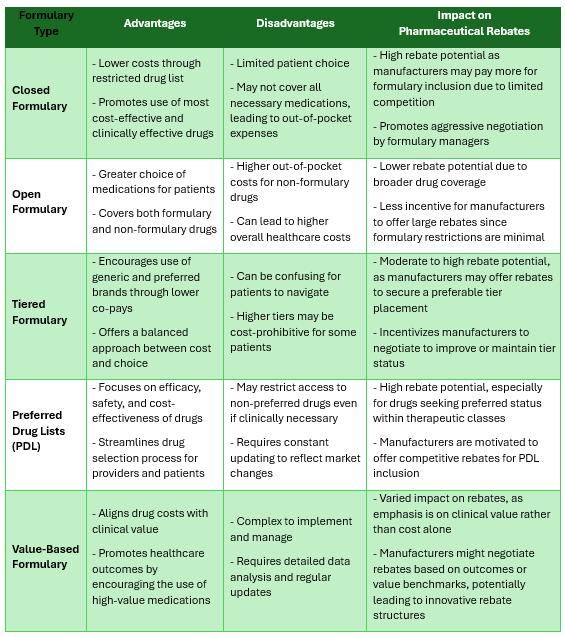In the world of pharmacy benefits management, formularies stand as a cornerstone, guiding the dispensation of medications based on efficacy, safety, and cost-effectiveness. For pharmaceutical manufacturers, understanding the nuances of different formulary types is crucial, as these can significantly influence rebate agreements and market access. Today, we delve into five types of formularies through the lens of pharmaceutical manufacturers, including the progressive value-based formulary, to uncover how each affects the dynamic landscape of pharmaceutical rebates.
1. Open
Open formularies offer the widest range of drugs, imposing few restrictions. This inclusivity means pharmaceutical manufacturers face less pressure to provide steep rebates to secure formulary placement. However, this openness can lead to higher overall drug costs for payers.
2. Closed
Closed formularies represent the other end of the spectrum, listing a more restricted range of drugs. For manufacturers, securing a spot on these formularies often necessitates offering substantial rebates. The exclusivity can drive competitive pricing but might limit patient access to certain drugs.
3. Tiered
Tiered formularies categorize drugs based on cost-sharing levels. Drugs in lower tiers cost patients less, incentivizing manufacturers to offer competitive rebates for favorable tier placement. This structure encourages cost efficiency while maintaining a range of options.
4. Preferred Drug Lists (PDLs)
PDLs highlight a subset of drugs within a formulary, chosen for their value in terms of efficacy and cost. Manufacturers may need to offer rebates or demonstrate superior value to get their drugs listed as preferred. This list can influence prescribing habits significantly.
5. Value-Based
Value-based formularies prioritize drugs based on their overall value to patient health outcomes, potentially adjusting cost-sharing to encourage the use of more effective treatments. Manufacturers whose drugs demonstrate high value may gain favorable placement without the same emphasis on rebates. This approach aligns costs more closely with outcomes. Each formulary type presents unique advantages and challenges for pharmaceutical manufacturers, especially concerning the negotiation of rebates.
Conclusion
The relationship between formulary management and pharmaceutical rebates is a dynamic and complex one. For pharmaceutical manufacturers, understanding and navigating the different formulary types is crucial to their strategy for securing formulary placement and optimizing rebate agreements. From the perspective of TransparentRx, leveraging this understanding allows us to negotiate better terms, ultimately benefiting our members through access to effective and affordable medications.
As the healthcare landscape evolves, so too will the strategies around formulary management and rebate negotiation. Staying informed and adaptable is key to navigating these changes effectively, ensuring that we continue to meet the needs of our members while fostering sustainable relationships with pharmaceutical manufacturers.

